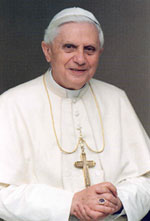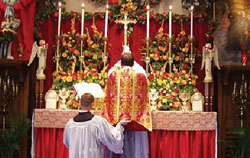 On July 7, 2007, the Vatican published Pope Benedict XVI’s new apostolic letter "Summorum Pontificum" (in Latin, the supreme pontiffs), issued "motu proprio" (on the Pope’s own initiative) allowing a wider use of the Roman Missal promulgated by John XXIII in 1962, which is sometimes also called the Latin Mass, or the Tridentine Mass (after the Council of Trent), which was in use in the universal Church until the 1970 reform of the Mass, sometimes called the Novus Ordo liturgy.
On July 7, 2007, the Vatican published Pope Benedict XVI’s new apostolic letter "Summorum Pontificum" (in Latin, the supreme pontiffs), issued "motu proprio" (on the Pope’s own initiative) allowing a wider use of the Roman Missal promulgated by John XXIII in 1962, which is sometimes also called the Latin Mass, or the Tridentine Mass (after the Council of Trent), which was in use in the universal Church until the 1970 reform of the Mass, sometimes called the Novus Ordo liturgy.
The Pope accompanied this document with a letter to all the Bishops of the world explaining his gesture, saying that this move was motivated by a desire to bring about "an interior reconciliation in the heart of the Church," because many faithful are still attached to this old form of the liturgy.
But, as mentioned in an analysis by Phil Lawler of CWN.com, what is most interesting in this document, and was missed by most of the news media reporting the news, is that Pope Benedict notes that "the two forms of the usage of the Roman rite can be mutually enriching," and hopes that the wider use of the old form, with its scrupulous attention to rubrics, will encourage a more faithful and reverent approach to the ordinary form in the Novus Ordo Mass. Mr. Lawler commented:
"That passage confirms that Pope Benedict sees Summorum Pontificum as one necessary step in a long-term reform of the liturgy. He apparently hopes that some elements of the new Novus Ordo liturgy will be integrated into the old Mass, while as some aspects of the extraordinary form will enrich the ordinary. In the long term, one suspects, the Pope sees a convergence of the two forms, bringing about the true organic reform of the liturgy that Vatican II envisioned."
Here are excerpts from Summorum Pontificum, and from the explanatory letter to the Bishops:
"Vatican Council II expressed a desire that the respectful reverence due to divine worship should be renewed and adapted to the needs of our time. Moved by this desire our predecessor, the Supreme Pontiff Paul VI, approved, in 1970, reformed and partly renewed liturgical books for the Latin Church. These, translated into the various languages of the world, were willingly accepted by bishops, priests and faithful. "But in some regions, no small numbers of faithful adhered and continue to adhere with great love and affection to the earlier liturgical forms.
"Following the insistent prayers of these faithful, long deliberated upon by our predecessor John Paul II, and after having listened to the views of the Cardinal Fathers of the Consistory of March 22, 2006, having reflected deeply upon all aspects of the question, invoked the Holy Spirit and trusting in the help of God, with these Apostolic Letters we establish the following:
"The Roman Missal promulgated by Paul VI is the ordinary expression of the ‘Lex orandi’ (Law of prayer) of the Catholic Church of the Latin rite. Nonetheless, the Roman Missal promulgated by St. Pius V and reissued by Bl. John XXIII is to be considered as an extraordinary expression of that same ‘Lex orandi,’ and must be given due honour for its venerable and ancient usage. These two expressions of the Church’s Lex orandi will in no way lead to a division in the Church’s ‘Lex credendi’ (Law of belief). They are, in fact two usages of the one Roman rite.
"It is, therefore, permissible to celebrate the Sacrifice of the Mass following the typical edition of the Roman Missal promulgated by Bl. John XXIII in 1962 and never abrogated, as an extraordinary form of the Liturgy of the Church.
"Communities of Institutes of consecrated life and of Societies of apostolic life, of either pontifical or diocesan right, wishing to celebrate Mass in accordance with the edition of the Roman Missal promulgated in 1962, for conventual or "community" celebration in their oratories, may do so.
"In parishes, where there is a stable group of faithful who adhere to the earlier liturgical tradition, the pastor should willingly accept their requests to celebrate the Mass according to the rite of the Roman Missal published in 1962."
And now, excerpts from the explanatory letter of Pope Benedict to the Bishops:
 "My dear Brother Bishops, this document is the fruit of much reflection, numerous consultations and prayer. News reports and judgments made without sufficient information have created no little confusion. There have been very divergent reactions ranging from joyful acceptance to harsh opposition, about a plan whose contents were in reality unknown. This document was most directly opposed on account of two fears, which I would like to address somewhat more closely in this letter.
"My dear Brother Bishops, this document is the fruit of much reflection, numerous consultations and prayer. News reports and judgments made without sufficient information have created no little confusion. There have been very divergent reactions ranging from joyful acceptance to harsh opposition, about a plan whose contents were in reality unknown. This document was most directly opposed on account of two fears, which I would like to address somewhat more closely in this letter.
"In the first place, there is the fear that the document detracts from the authority of the Second Vatican Council, one of whose essential decisions – the liturgical reform – is being called into question.
"This fear is unfounded. In this regard, it must first be said that the Missal published by Paul VI and then republished in two subsequent editions by John Paul II, obviously is and continues to be the normal Form – the Forma ordinaria – of the Eucharistic Liturgy. The last version of the Missale Romanum prior to the Council, which was published with the authority of Pope John XXIII in 1962 and used during the Council, will now be able to be used as a Forma extraordinaria of the liturgical celebration. It is not appropriate to speak of these two versions of the Roman Missal as if they were ‘two Rites’. Rather, it is a matter of a twofold use of one and the same rite.
"As for the use of the 1962 Missal as a Forma extraordinaria of the liturgy of the Mass, I would like to draw attention to the fact that this Missal was never juridically abrogated and, consequently, in principle, was always permitted. At the time of the introduction of the new Missal, it did not seem necessary to issue specific norms for the possible use of the earlier Missal. Probably it was thought that it would be a matter of a few individual cases which would be resolved, case by case, on the local level.
"Afterwards, however, it soon became apparent that a good number of people remained strongly attached to this usage of the Roman Rite, which had been familiar to them from childhood. This was especially the case in countries where the liturgical movement had provided many people with a notable liturgical formation and a deep, personal familiarity with the earlier form of the liturgical celebration. We all know that, in the movement led by Archbishop Lefebvre, fidelity to the old Missal became an external mark of identity; the reasons for the break which arose over this, however, were at a deeper level.
"Many people who clearly accepted the binding character of the Second Vatican Council, and were faithful to the Pope and the Bishops, nonetheless also desired to recover the form of the sacred liturgy that was dear to them. This occurred above all because in many places celebrations were not faithful to the prescriptions of the new Missal, but the latter actually was understood as authorizing or even requiring creativity, which frequently led to deformations of the liturgy which were hard to bear. I am speaking from experience, since I too lived through that period with all its hopes and its confusion. And I have seen how arbitrary deformations of the liturgy caused deep pain to individuals totally rooted in the faith of the Church.
"In the second place, the fear was expressed in discussions about the awaited Motu Proprio, that the possibility of a wider use of the 1962 Missal would lead to disarray or even divisions within parish communities. This fear also strikes me as quite unfounded. The use of the old Missal presupposes a certain degree of liturgical formation and some knowledge of the Latin language; neither of these is found very often. Already from these concrete presuppositions, it is clearly seen that the new Missal will certainly remain the ordinary Form of the Roman Rite, not only on account of the juridical norms, but also because of the actual situation of the communities of the faithful.
"It is true that there have been exaggerations and at times social aspects unduly linked to the attitude of the faithful attached to the ancient Latin liturgical tradition. Your charity and pastoral prudence will be an incentive and guide for improving these. For that matter, the two Forms of the usage of the Roman Rite can be mutually enriching: new Saints and some of the new Prefaces can and should be inserted in the old Missal. The "Ecclesia Dei" Commission will study the practical possibilities in this regard. The celebration of the Mass according to the Missal of Paul VI will be able to demonstrate, more powerfully than has been the case hitherto, the sacrality which attracts many people to the former usage. The most sure guarantee that the Missal of Paul VI can unite parish communities and be loved by them consists in its being celebrated with great reverence in harmony with the liturgical directives. This will bring out the spiritual richness and the theological depth of this Missal.
"There is no contradiction between the two editions of the Roman Missal. In the history of the liturgy there is growth and progress, but no rupture. What earlier generations held as sacred, remains sacred and great for us too, and it cannot be all of a sudden entirely forbidden or even considered harmful. It behooves all of us to preserve the riches which have developed in the Church’s faith and prayer, and to give them their proper place. Needless to say, in order to experience full communion, the priests of the communities adhering to the former usage cannot, as a matter of principle, exclude celebrating according to the new books. The total exclusion of the new rite would not in fact be consistent with the recognition of its value and holiness.
Pope Benedict XVI